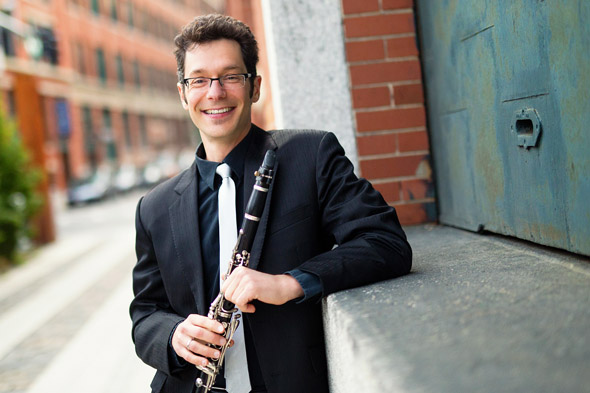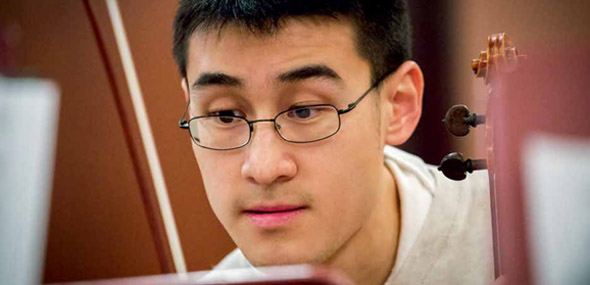Profile: Eran Egozy
Harmonix co-founder returns to MIT as Professor of the Practice in Music Technology

“Technology and humanity are now deeply interlinked. It’s important for people graduating with a technical or scientific degree to be immersed in the arts.”
— Eran Egozy, MIT Professor of the Practice in Music Technology; engineer, musician, and new media pioneer
MIT alumnus Eran Egozy who co-founded Harmonix Music Systems and launched the hugely successful video games "Guitar Hero" and "Rock Band," never took a class at MIT that combined his passion for computers and music. That's because when he was an undergraduate in the early '90s, there weren't any.
Today there are several, and Egozy is back on campus teaching one of them: 21M.385/6.809, Interactive Music Systems, the first MIT music class that is also a Course 6 class. The upper-level undergraduate course enables MIT students to explore audio synthesis, musical structure, and human-computer interaction. Ultimately, the students produce their own interactive music systems.
Using interactive technology to deepen music making and experience
"I'm interested in ways of using technology to enhance a person's experience in either listening to or making music," says Egozy, who was recently named a professor of the practice in MIT Music, based in the School of Humanities, Arts, and Social Sciences.
"People often experience music passively, by simply turning on a playlist in the background. But the inner workings of music are incredibly deep, and I believe every person has the capability of understanding and engaging with music in a much deeper way than they do now, even if they have not been formally trained."
At Harmonix, Egozy and co-founder Alex Rigopulos (also an MIT alumnus) designed "Guitar Hero" to give users the experience of playing an instrument. Later games enabled players to re-create the experience of playing in a rock band or performing as a dancer. One of the pre-eminent game development studios in the world, Harmonix has developed more than a dozen critically acclaimed music-based video games.

"Music exercises the artistic part of your brain, which encourages creativity, and that creativity can be applied to engineering and science. But I think students should take classes in the humanities and arts simply because they are rich and wonderful subjects in their own right. And ultimately, the truly great things that happen in the world happen when people pursue the work they love."
— Eran Egozy, MIT Professor of the Practice in Music Technology
Teaching interactive music systems
At MIT, Egozy says he hopes to continue researching ways in which computers can help people understand music while also helping students pursue their own passions — because he thinks that's the key to success. "We started Harmonix not because we wanted to make a bunch of money, but because we wanted to continue playing around with interactive music technologies after graduating," he says.
Though he is now full time at MIT, Egozy still keeps in close touch with Harmonix and continues to serve on the company’s board of directors. Recently, Egozy had a chance to show his students the Harmonix ethos in action, during a tour of the studio. "It was a really fun day," he says. "The students got to see the inner-workings of Harmonix, and see demos of our products, some of which have not yet been released."
An accomplished clarinetist with the Radius Ensemble, Egozy first developed the Interactive Music Systems class for the spring 2015 term, when he came to MIT as a visiting artist. Eighty undergrads pre-registered for that first class, and Egozy admitted 16 students who gradually moved from simple programming tasks — such as creating a virtual harp that can be played with Kinect motion sensors — to their final project for the class: designing a system that incorporates sounds, graphics, and animation.
Algorithms for understanding music
Egozy expected the 2015 class to be a one-off, but he found he enjoyed teaching enormously. So, when he learned that MIT Music had an opening for a professor of music technology, he immediately applied. "This was the first time I had to actually apply for a job," he says. "It's pretty intense."
Egozy secured the position and officially joined the faculty in the Spring 2016 term — when he again offered Interactive Music Systems. Now, he is developing a new undergraduate class focused on the algorithms that enable computers to understand music and he is delighted to be back at MIT Music — "this hidden gem" that he discovered as an undergraduate.
Music and the MIT mission
"As an MIT undergraduate, I did not at all regret coming here, rather than going to a conservatory, which was the other choice I was considering," says Egozy, who received S.B. and M.Eng. degrees from MIT in electrical engineering with a minor in Music Performance. "Once you're here, at MIT, you can do whatever you want."
The key, he says, is passion. "Why take a music class? It exercises the artistic part of your brain, which encourages creativity, and that creativity can certainly be applied to engineering and science," he says. "But I think students should take classes in the humanities and arts simply because they are rich and wonderful subjects. Ultimately, the truly great things that happen in the world happen when people pursue the work they love."

Related links
Eran Egozy MIT webpage
@EEgozy
Eran Egozy Twitter handle
Learn more about 21M.385/6.809 - Interactive Music Systems
MIT Music | MIT Music subjects
Radius Ensemble
Musical Institute of Technology
A book about music and the MIT mission
The Listening Room
The finest works from MIT music online
Archive | 3Q: A world-premiere concert where the audience helps play
MIT’s Eran Egozy on “12,” a chamber music debut with smartphone-driven percussion
Archive | Gamma sonification
MIT students make music from particle energy
Video: The science of how playing an instrument benefits the brain
"When you listen to music, multiple areas of your brain become engaged and active. But when you actually play an instrument, that activity becomes more like a full-body brain workout. What's going on?"
Story prepared by SHASS Communicaitons
Editorial and Design Director: Emily Hiestand
Senior Writer: Kathryn O'Neill
Photograph of Eran Egozy: Kate Lemmon
Photographs of MIT student musicians: Jon Sachs